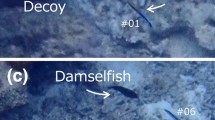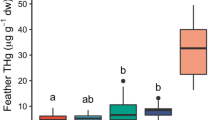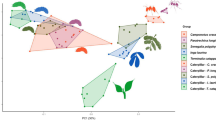Abstract
European starlings (Sturnus vulgaris) are responsible for high rates of egg predation at one of the main colonies of the endangered roseate tern (Sterna dougallii) in the Azores archipelago. Control taste aversion has been effective in controlling raven predation in a colony of California least tern (Sterna antillarum browni), but there is little quantitative information about its efficacy on other species of predators taking eggs. We conducted a control taste aversion experiment on yellow-legged gulls (Larus michahellis) and European starlings eating eggs of terns in a mixed colony of common (Sterna hirundo) and roseate terns in the Azores. We treated quail (Coturnix coturnix) eggs with methiocarb and deployed them in artificial nests in the tern colony. On the first experiment, conducted before the terns laid eggs, predation rates on quail eggs by yellow-legged gulls showed significant and rapid decrease after deployment of treated eggs. During the second experiment, after the terns had started laying, results were mixed. Although predation rates by European starlings on treated quail eggs decreased, predation rates on tern eggs did not. We conclude that control taste aversion using methiocarb-treated eggs is likely to reduce depredation by gulls but not starlings because of the need to pre-train the birds and the tendency of starlings to be attracted by the movement of adults, not the presence of nests.


Similar content being viewed by others
References
Avery ML (1985) Application of mimicry theory to bird damage control. J Wildl Manage 49:1116–1121
Avery ML, Decker DG (1994) Responses of captive fish crows to eggs treated with chemical repellents. J Wildl Manage 58:261–266
Avery ML, Mason JR (1997) Feeding responses of red-winged blackbirds to multisensory repellents. Crop Prot 16:159–164
Avery ML, Pavelka MA, Bergman DL, Decker DG, Knittle CE, Linz GM (1995) Aversive conditioning to reduce raven predation on California least tern eggs. Colon Waterbirds 18:131–138
Becker PH (1995) Effects of coloniality on gull predation on common tern (Sterna hirundo) chicks. Colon Waterbirds 18:11–22
Burger J, Gochfeld M (1994) Predation and effects of humans on island-nesting seabirds. In: Nettleship DN, Burger J, Gochfeld M (eds) Seabirds on islands: threats, case studies and action plans. Bird life conservation series no 1. Bird Life International, Cambridge, pp 39–67
Clark L, Mason JR (1993) Interaction between sensory and postingestional repellents in starlings—methyl anthranilate and sucrose. Ecol Appl 3:262–270
Conover MR (1984) Response of birds to different types of food repellents. J Appl Ecol 21:437–443
Cowan DP, Reynolds JC, Gill EL (2000) Manipulating predatory behaviour through conditioned taste aversion: can it help endangered species? In: Gosling LM, Sutherland WJ, Avery M (eds) Behaviour and conservation. Cambridge University Press, Cambridge, UK, pp 281–299
Crocker DR, Perry SM (1990) Plant chemistry and bird repellents. Ibis 132:300–308
Dimmick CR, Nicolaus LK (1990) Efficiency of conditioned aversion in reducing depredation by crows. J Appl Ecol 27:200–209
Feare C (1984) The starling. Oxford University Press, New York
Guillemette M, Brousseau P (2001) Does culling predatory gulls enhance the productivity of breeding common terns? J Appl Ecol 38:1–8
Hays H, Neves VC, Lima P (2002) Banded roseate terns from different continents trapped in the Azores. J Field Ornithol 73:180–184
Hernández-Matías A, Ruiz X (2003) Predation on common tern eggs by the yellow-legged gull at the Ebro Delta. Sci Mar 67(Suppl 2):95–101
Kononen DK, Hochstein JR, Ringer RK (1986) A quantitative method for evaluating food avoidance behaviour. Environ Toxicol Chem 5:823–830
Mason JR, Reidinger RF (1983) Importance of color for methiocarb-induced food aversions in red-winged blackbirds. J Wildl Manage 47:383–393
Monteiro LR (2000) The Azores. In: Heath MF, Evans MI (eds) Important bird areas in Europe. pp 463–471
Newbery P (ed) (2002) International (East Atlantic) action plan for roseate tern Sterna dougallii. Document prepared by Bird Life International on behalf of the European Commission
Nicolaus LK, Nellis D (1987) The first evaluation of the use of conditioned taste aversion to control predation by mongooses upon eggs. Appl Anim Behav Sci 17:329–334
Nicolaus LK, Cassel JF, Carlson RB, Gustavson CR (1983) Taste-aversion conditioning of crows to control predation on eggs. Science 220:212–214
Nicolaus LK, Herrera J, Nicolaus JC, Gustavson CR (1989) Ethinyl estradiol and generalized aversions to eggs among free-ranging predators. Appl Anim Behav Sci 24:313–324
Nisbet ICT (2000) Disturbance, habituation, and management of waterbird colonies—commentary. Waterbirds 23:312–332
O’Connell TJ, Beck RA (2003) Gull predation limits nesting success of terns and skimmers on the Virginia barrier islands. J Field Ornithol 74:66–73
Ramos JA, del Nevo AJ (1995) Nest-site selection by Roseate Terns and Common Terns in the Azores. Auk 112:580–589
Ratcliffe N (ed) (2000) Roseate tern newsletter no. 12, RSPB
Reichel JD, Glass PO (1990) Micronesian starling predation on seabird eggs. Emu 90:135–136
Rogers JG Jr (1974) Responses of caged red-winged blackbirds to two types of repellents. J Wildl Manage 38:418–423
Sayre RW, Clark L (2001) Effect of primary and secondary repellents on European starlings: An initial assessment. J Wildl Manage 65:461–469
Tobin ME (1985) Cues used by European starlings for detecting methiocarb-treated grapes. J Wildl Manage 49:1102–1108
Whittam RM, Leonard ML (1999) Predation and breeding success in roseate terns Sterna dougallii. Can J Zool 77:851–856
Yorio P, Quintana F (1997) Predation by kelp gulls Larus dominicanus at a mixed-species colony of royal terns Sterna maxima and cayenne terns Sterna eurygnatha in Patagonia. Ibis 139:536–541
Acknowledgement
Funding for this project was provided by the Portuguese Foundation for Science and Technology for funding (grant SFRH/BD/3436/ 2000) and the Glasgow Natural History Society. We thank J. Simón (Eurodissey programme), H. Simões and M. Santos for their help with fieldwork; J. Maria for transport to the islet; R. Santos for finding a farmer who could provide quail eggs, and M. Cormons for comments on an earlier draft of the manuscript. The experiments conducted in this study comply with the Portuguese laws and were performed under permit no. 3/CN/2003 from “Direcção de Serviços de Conservação da Natureza”, Environment Secretary.
Author information
Authors and Affiliations
Corresponding author
Rights and permissions
About this article
Cite this article
Neves, V.C., Panagiotakopoulos, S. & Furness, R.W. A control taste aversion experiment on predators of roseate tern (Sterna dougallii) eggs. Eur J Wildl Res 52, 259–264 (2006). https://doi.org/10.1007/s10344-006-0044-4
Received:
Accepted:
Published:
Issue Date:
DOI: https://doi.org/10.1007/s10344-006-0044-4




